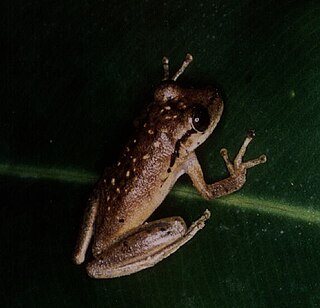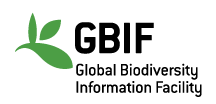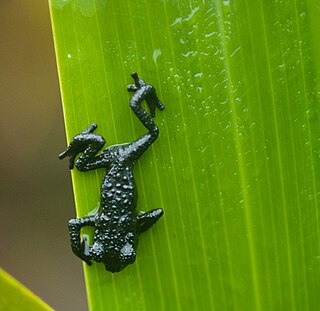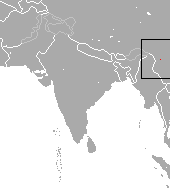
Trinidad is the larger and more populous of the two major islands of Trinidad and Tobago. The island lies 11 km (6.8 mi) off the northeastern coast of Venezuela and sits on the continental shelf of South America. It is often referred to as the southernmost island in the West Indies. With an area of 4,768 km2 (1,841 sq mi), it is also the fifth largest in the West Indies.

Scinax is a genus of frogs, commonly known as snouted treefrogs, in the family Hylidae. The genus is found from eastern and southern Mexico to Argentina and Uruguay, and in Trinidad and Tobago, and Saint Lucia. Member species are small to moderate-sized tree frogs, drably colored. Duellman and Wiens resurrected this genus in 1992. The name originates from the Greek word skinos, meaning quick or nimble.

Triprion is a genus of frogs in the family Hylidae found in the Pacific lowlands of Mexico, the Yucatán Peninsula, and Guatemala. These frogs hide in tree-holes and plug the entrance with their strange-looking, bony heads.

Pseudacris is a genus of frogs in the family Hylidae found in North America ranging from the Pacific coastline to the Atlantic.

Phyllodytes is a genus of frogs in the family Hylidae. It is endemic to eastern Brazil.

The Global Biodiversity Information Facility (GBIF) is an international organisation that focuses on making scientific data on biodiversity available via the Internet using web services. The data are provided by many institutions from around the world; GBIF's information architecture makes these data accessible and searchable through a single portal. Data available through the GBIF portal are primarily distribution data on plants, animals, fungi, and microbes for the world, and scientific names data.

Nectophryne, or African tree toads, is a small genus of true toads with only two species. They are native to West and Central Africa: Nigeria, Cameroon, Gabon, northeastern Congo, Bioko and Equatorial Guinea. Nectophryne afra uses small bodies of water to lay its eggs which are then guarded by the male.

Oreophrynella, commonly known as bush toads, is a genus of true toads native to the tepuis of southern Venezuela and adjacent Guyana. The distribution of some species is restricted to a couple of tepuis or even a single tepui, as in the case of Oreophrynella weiassipuensis, which occurs on Wei-Assipu-tepui.

The gold tegu, also known as the golden tegu, common tegu, black tegu, Colombian black and white tegu and tiger lizard, is a species of tegu.

The Encyclopedia of Life (EOL) is a free, online encyclopedia intended to document all of the 1.9 million living species known to science. It aggregates content to form "page"s for every known species. Content is compiled from existing trusted databases which are curated by experts and it calls on the assistance of non-experts throughout the world. It includes video, sound, images, graphics, information on characteristics, as well as text. In addition, the Encyclopedia incorporates species-related content from the Biodiversity Heritage Library, which digitizes millions of pages of printed literature from the world's major natural history libraries. The BHL digital content is indexed with the names of organisms using taxonomic indexing software developed by the Global Names project. The EOL project was initially backed by a US$50 million funding commitment, led by the MacArthur Foundation and the Sloan Foundation, who provided US$20 million and US$5 million, respectively. The additional US$25 million came from five cornerstone institutions—the Field Museum, Harvard University, the Marine Biological Laboratory, the Missouri Botanical Garden, and the Smithsonian Institution. The project was initially led by Jim Edwards and the development team by David Patterson. Today, participating institutions and individual donors continue to support EOL through financial contributions.

Nowellia is a genus of liverwort in the family Cephaloziaceae. The name of this genus is in honour of William Nowell (1880–1968), a British botanist and mycologist, who conducted researched in Trinidad and authored the book Diseases of crop-plants in the Lesser Antilles (1923).
Chodsigoa is a genus of shrews in the tribe Nectogalini.

Van Sung's shrew, also known as Cao Van Sung mountain shrew is a species of shrew in the Soricomorpha order. Specimens of Chodsigoa caovansunga have been found in Vietnam.

The pygmy brown-toothed shrew is a species of shrew in the order Eulipotyphla. It is distributed in China. C. parva was initially thought to be the same as Chodsigoa lamula, but it was found to be a separate species.
Aalatettix is a genus of groundhopper, in the family Tetrigidae, with species found in southern China.

Keith Christopher Rowley, is a Trinidadian politician serving as the seventh prime minister of Trinidad and Tobago, first elected into office on 9 September 2015 and again following the 2020 general election. He has led the People's National Movement (PNM) since May 2010 and was Leader of the Opposition from 2010 to 2015. He has also served as the Member of the House of Representatives for Diego Martin West since 1991. He is a volcanologist by profession, holding a doctorate in geology, specializing in geochemistry.
Holothuria (Cystipus) cubana is a species of sea cucumber in the family Holothuriidae. This species was first described by Ludwig in 1875.
Echiniscus madonnae is a tardigrade species, genus of Echiniscus. It was described by Polish zoologists Michalczyk and Kaczmarek Łukasz in South America in 2006, and named in honor of American singer-songwriter Madonna.
Andaingo is a genus of moths in the family Limacodidae.

Leptobatopsis is a genus of parasitic ichneumon wasp. Species of Leptobatopsis are diurnal.














